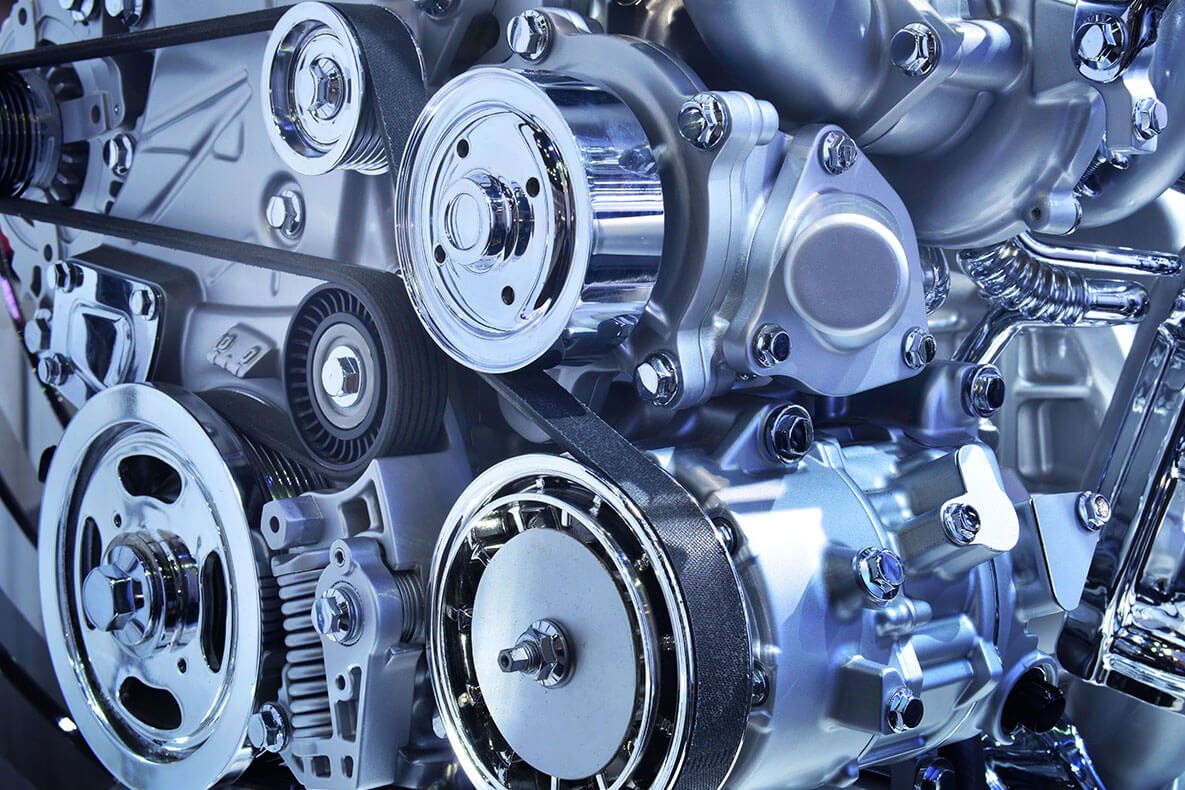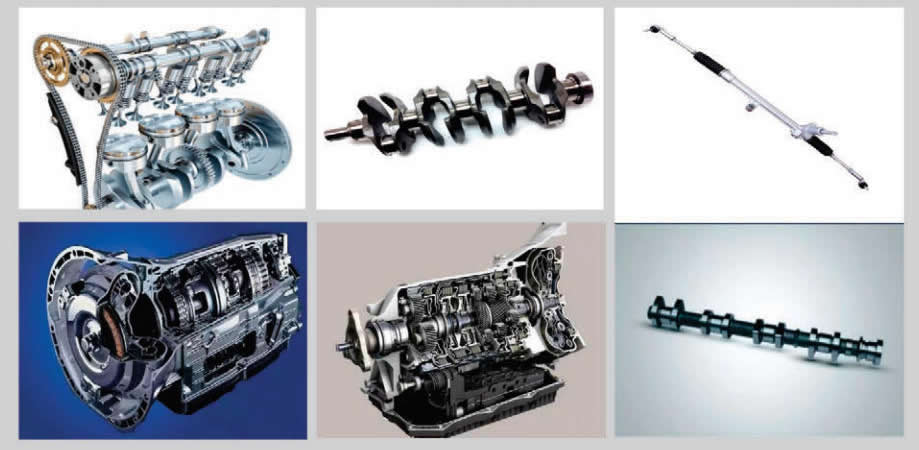Auto parts
2025/4/15 18:42:50
Auto parts polishing solution
In the automotive manufacturing process, the surface quality of the parts is crucial to the performance, appearance and durability of the vehicle. Especially in the manufacturing process of engine parts, body surfaces, precision components and other components, polishing technology helps to improve the surface finish of parts, reduce friction, and improve product quality and service life.
The following are the polishing solutions for automotive parts, including the selection of polishing methods and materials for different types of parts to ensure an efficient, high-quality surface finish.

1. Grinding and polishing material selection
According to the different materials and surface quality requirements of automotive parts, it is important to choose the right polishing material. Common polishing materials include:
Diamond grinding materials: For high-hardness metal such as steel, aluminum and other parts of the precision polishing, can provide excellent polishing effect, especially in the precision automotive engine parts.
Alumina grinding material: suitable for metal, plastic and rubber and other materials, has a good surface polishing effect, widely used in the treatment of automotive appearance parts.
Silicon carbon abrasive material: mainly used in the roughing stage, with high removal efficiency, suitable for removing large defects and irregular surfaces.
Cerium oxide (CeO₂) grinding material: Used in the super-finishing stage, it is particularly suitable for surface polishing with high finish requirements, such as glass and ceramic parts.
2. Grinding and polishing process
Roughing stage (RA>0.1µm)
Tools and materials: A coarse diamond, silicon carbide or alumina strip with a particle size of 30µm, 15µm or 6µm combined with a coolant is used for grinding.
Process features: Remove large defects and surface irregularities, reduce the overall roughness. Mechanical grinding is available to ensure efficient removal of irregular layers.
Intermediate finishing stage (RA>0.05µm)
Tools and materials: 12µm to 3µm diamond belt or alumina belt.
Process characteristics: continue to remove the surface of the small non-uniformity, refine the surface texture.
Operation method: Low pressure polishing, using a high speed to ensure smooth and uniform surface.
Fine processing stage (RA>0.01µm)
Tools and materials: Use 3µm to 1µm diamond or alumina belts to further optimize surface quality.
Process features: By polishing the surface to remove small scratches and defects, to achieve a high finish.
Operation method: Low speed, low pressure operation, use the right amount of grinding fluid to reduce friction and avoid thermal damage.
Superfinishing stage (RA<0.01µm)
Tools and materials: Ultrafine cerium oxide (CeO₂) grinding fluid or ultrafine alumina with a particle size of less than 1µm.
Process characteristics: At this stage, the surface finish reaches a mirror effect, especially suitable for high-precision parts surfaces.
Operation method: Use polishing cloth or foam cloth with grinding liquid for low-speed and low-pressure precision polishing to ensure that the surface quality meets the mirror standard.
3. Selection of polishing fluid
The polishing fluid plays an important role in the polishing of auto parts, such as lubrication, cooling, removal of abrasive debris and improvement of polishing effect. According to different polishing stages and needs, the following types of polishing fluids can be selected:
Diamond grinding liquid: Used for rougher grinding stage, providing strong cutting force and high removal efficiency, suitable for the polishing of metals and high hardness materials.
Alumina grinding liquid: Suitable for fine polishing stage, can effectively remove the surface of the fine scratches, improve the surface finish.
Cerium oxide grinding liquid: Used in the ultra-finishing stage, especially for glass, ceramics and high hardness materials, providing excellent mirror polishing results.
Water-based polishing liquid: suitable for removing oxide layer on metal surface, providing good cooling and lubrication effect, suitable for general polishing of auto parts.
4. Different materials and polishing requirements for auto parts
Engine parts (e.g., cylinder head, piston, crankshaft)
Roughing: Using diamond or silicon carbide belts with particle sizes from 30µm to 15µm.
Fine machining: Use 6µm to 3µm diamond belt.
Superfinishing: Use a cerium oxide lapping solution below 1µm.
External body parts (e.g. doors, hood, window frames)
Roughing: Use alumina or silicon carbide sand strip with a particle size of 30µm.
Fine processing: Use aluminum oxide sanding bands from 15µm to 6µm.
Superfinishing: Use a cerium oxide abrasive solution below 1µm to ensure a mirror-grade surface finish.
Brake system components (e.g. brake discs, brake pads)
Roughing: Use 30µm diamond belt.
Fine machining: 12µm to 3µm diamond belt.
Superfinishing: Use a cerium oxide abrasive solution below 1µm to ensure a flat surface without tiny scratches and improve brake performance.
Aluminum, plastic and rubber parts (e.g. exterior trim, instrument panel, interior accessories)
Roughing: Use 15µm to 12µm alumina sanding.
Fine processing: Use 6µm to 3µm alumina sanding.
Superfinishing: Use a cerium oxide abrasive solution below 1µm to ensure a smooth and scratch-free surface.
5. Polishing equipment selection
Polishing machine: The automatic or semi-automatic polishing machine can accurately control the polishing speed, pressure and time to ensure stable polishing quality.
CNC polishing machine: Suitable for high-precision automotive parts, it can accurately control the key parameters in the grinding and polishing process to ensure high-quality polishing effect.
6. Field of application
Engine parts: improve engine working efficiency, reduce friction, improve the durability of parts.
External parts of the body: improve the appearance quality of the body, reduce surface defects, and enhance the weather resistance of the body.
Brake system components: improve the surface quality and performance of the brake disc, enhance the braking effect.
Interior and exterior trim: Improve the finish of the interior and exterior trim, enhance the texture of the vehicle appearance and interior trim.
7. Conclusion
By selecting the right polishing materials, precisely controlling the grinding and polishing process and using efficient polishing fluids, automotive parts polishing solutions can effectively improve the surface finish and durability of the parts. For different types of parts and materials, the development of personalized polishing solutions, help to improve the quality of the vehicle, reduce friction loss, improve the overall performance and appearance of the car.
Can solve the following product grinding requirements

Classic recommended products

Specification parameter
| Aluminum Oxide/silicon carbide | |||||||||
| Mesh | 150# | 180# | 240# | 320# | 360# | 500# | 800# | 1200# | 2000# |
| um | 100 | 80 | 60 | 50 | 40 | 30 | 20 | 15 | 9 |
| Standardspecification | (32mm、28mm、19.5mm)*50m,(32mm、28mm、19.5mm)*200m | ||||||||
| Standardspecification | 44mm(W)x30m(L)x9.5mm(H)x13mm (W) 54.4mm(W)x30m(L)x12.7mm(H)x12.7mm(W) 35.5mm(W)x30m(L)x3.5mm(H)x10mm(W) 53mm(W)x100m(L)x6mm(H)x9mm(W) 29.76mm(W)x45.72m(L)x8mm(H)x12mm(W) | ||||||||
| Note: The standard has a non- slip layer and non -slip layer type can also be customized upon request.Apart from above specifications,we can produce special specifications accordingto customer's specific requirements. | |||||||||
- 上一页: Roll making industry
- 下一页: LED/LCD/OLED
 English
English 中文
中文
